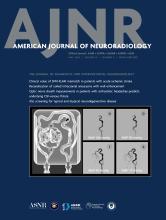This article requires a subscription to view the full text. If you have a subscription you may use the login form below to view the article. Access to this article can also be purchased.
Abstract
BACKGROUND AND PURPOSE: The slow adoption of new advanced imaging techniques into clinical practice has been a long-standing challenge. Principles of implementation science and the reach, effectiveness, adoption, implementation, maintenance (RE-AIM) framework were used to build a clinical vessel wall imaging program at an academic medical center.
MATERIALS AND METHODS: Six phases for implementing a clinical vessel wall MR imaging program were contextualized to the RE-AIM framework. Surveys were designed and distributed to MR imaging technologists and clinicians. Effectiveness was measured by surveying the perceived diagnostic value of vessel wall imaging among MR imaging technologists and clinicians, trends in case volumes in the clinical vessel wall imaging examination, and the number of coauthored vessel wall imaging–focused publications and abstracts. Adoption and implementation were measured by surveying stakeholders about workflow. Maintenance was measured by surveying MR imaging technologists on the value of teaching materials and online tip sheets. The Integration dimension was measured by the number of submitted research grants incorporating vessel wall imaging protocols. Feedback during the implementation phases and solicited through the survey is qualitatively summarized. Quantitative results are reported using descriptive statistics.
RESULTS: Six phases of the RE-AIM framework focused on the following: 1) determining patient and disease representation, 2) matching resource availability and patient access, 3) establishing vessel MR wall imaging (VWI) expertise, 4) forming interdisciplinary teams, 5) iteratively refining workflow, and 6) integrating for maintenance and scale. Survey response rates were 48.3% (MR imaging technologists) and 71.4% (clinicians). Survey results showed that 90% of the MR imaging technologists agreed that they understood how vessel wall MR imaging adds diagnostic value to patient care. Most clinicians (91.3%) reported that vessel wall MR imaging results changed their diagnostic confidence or patient management. Case volumes of clinical vessel wall MR imaging performed from 2019 to 2022 rose from 22 to 205 examinations. Workflow challenges reported by MR imaging technologists included protocoling examinations and scan length. Feedback from ordering clinicians included the need for education about VWI indications, limitations, and availability. During the 3-year implementation period of the program, the interdisciplinary teams coauthored 27 publications and abstracts and submitted 13 research grants.
CONCLUSIONS: Implementation of a clinical imaging program can be successful using the principles of the RE-AIM framework. Through iterative processes and the support of interdisciplinary teams, a vessel wall MR imaging program can be integrated through a dedicated clinical pipeline, add diagnostic value, support educational and research missions at an academic medical center, and become a center for excellence.
ABBREVIATIONS:
- RE-AIM
- reach, effectiveness, adoption, implementation, maintenance
- VWI
- vessel wall MR imaging
- © 2024 by American Journal of Neuroradiology







